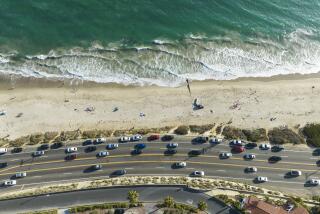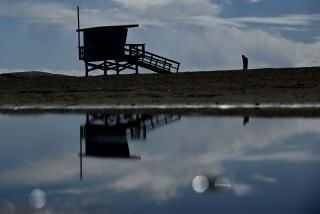Experts Criticize Dirty Beach Closure
Contamination that closed Huntington Beach for more than two months last summer might have been cut short if a county task force had used some key tests earlier, a panel of experts concluded Wednesday.
The panel of microbiologists, oceanographers and environmentalists concluded a three-day review of the beach closure and subsequent investigation as part of a program sponsored by USC’s Sea Grant Institutional Program for environmental studies.
Panel members heard presentations from task force members, including the Orange County Sanitation District, which spent more than $1.5 million investigating the contamination that closed the beach, hurting the city’s economy and spoiling its image as a haven for surfers. The panel also made recommendations for handling future incidents.
One mistake investigators made in tracking down the source of the contamination was not testing sooner to determine if the bacteria that caused it came from animals or humans.
Suspecting it might come from human waste, officials spent much time and effort looking for sewage leaks. Eventually, however, they concluded the contamination was caused by a combination of urban runoff and animal waste in the Talbert Marsh.
Had they identified the bacteria sooner as coming from animal waste, officials might have diverted water from the marsh into a treatment plant, possibly allowing the beach to reopen sooner, experts said.
Additionally, tests for water-borne viruses and also DNA fingerprinting should have been ordered during peak bacteria levels in July after investigators knew from samplings that they were high in June, panelists said. This could have helped pinpoint the cause of the contamination.
“I would have started virus testing in July when they had hits and hits of high bacteria,” said Joan B. Rose, a panelist and professor in the University of South Florida’s Department of Marine Science. “When you have a biological problem, it behooves us to do virus testing.
“There’s plenty of sophisticated tests out there that could have been conducted and weren’t,” she said.
Panelists also recommended the county adopt a better plan for handling a major “biological event” such as the Huntington Beach contamination.
With the sanitation district in charge of the investigation, the closures were conducted under a presumption the bacteria was caused by sewage, said Stephen B. Weisberg, director of the Southern California Coastal Water Research Project.
“There is no implication that the sanitation agency did anything wrong,” Weisberg said. “But in planning for the future, should the sanitation district take the lead? We see a potential negative because they have a different mission.”
Weisberg said hundreds of holes were punched in the ground and dozens of sewage pipelines were cleaned out and checked for sewage leaks and not other sources such as urban runoff during the early stages of the investigation.
“But if the Orange County public facilities agency was in charge, they might have targeted the Talbert Marsh earlier as a potential source,” he said.
The 25-acre wetlands preserve is on the inland side of Pacific Coast Highway at Brookhurst Street. It attracts thousands of migratory birds and other wildlife each year, part of the Talbert watershed that encompasses 12 square miles in Huntington Beach and Fountain Valley. Channels in the marsh have earthen walls that allow absorption, while marsh sediment is tainted by animal waste.
Ocean water flows into the channels during high tides and then back out, flushing marsh sediment that is carried to the shoreline less than a mile away.
(BEGIN TEXT OF INFOBOX / INFOGRAPHIC)
Beach Closure Revisited
Experts say the two-month closure of Huntington State Beach last summer was caused by urban runoff and bacteria from animal waste.
More to Read
Sign up for Essential California
The most important California stories and recommendations in your inbox every morning.
You may occasionally receive promotional content from the Los Angeles Times.










